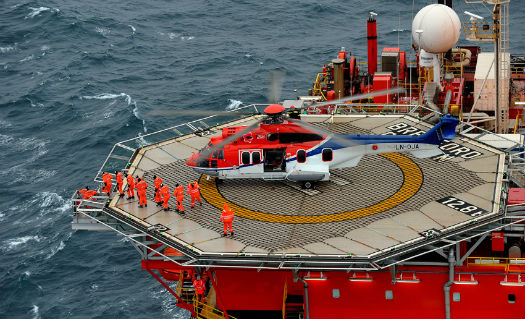
EASA’s NPA was shaped with input from across the industry, including helicopter manufacturers and offshore operators. Airbus Helicopters Photo
The European Aviation Safety Agency (EASA) is set to unveil a notice of proposed amendment (NPA) that could drastically affect the certification of new aircraft types for offshore operation. At the heart of the proposal, announced yesterday by the regulator at Helitech International in London, U.K., is an attempt to improve the survivability of a ditching or crash at sea, with requirements including the provision of an air pocket in the cabin if an aircraft capsizes, improved flotation, better egress, and remotely operated life rafts.
“The rules at the moment are really written around the assumption that the helicopter will not capsize, but that’s really not something you can eliminate as a risk in a ditched helicopter,” said Peter Chittenden, a Cabin Safety expert at EASA, who was speaking at a Rulemaking and Air Traffic Management Rotorcraft seminar at the event. Because of that, the NPA, which is designed to amend Certification Specifications for part 27 (small) and part 29 (large) rotorcraft, focuses on ensuring those inside a capsized aircraft can more easily survive — and make their escape.
“Any helicopter will capsize eventually in most sea conditions — it’s just a case of how long you have to wait for that bad wave, that awkward wave to come along and capsize you,” said Chittenden. Traditional testing, he added, is done with scale models in wave tanks with very regular waves — but he said it was a breaking wave that will cause a helicopter to capsize, and the new rules would require testing in more realistic (irregular) wave conditions.
“It’s going to be a probabilistic approach now,” he said. “It does allow you to capsize during the test, [but] there’s test specification that allows you to work out how much more testing you need to do each time you capsize to show that the overall probability meets the requirements.”
Switching the focus to a capsized aircraft, Chittenden said the requirement to create an air pocket showed one of the greatest potential for saving lives in the future.
“A lot of people drown in fatal helicopter crashes in the cabin — they never get out,” said Chittenden. “What we think is required in the future is an air pocket. When the helicopter capsizes, there will be remaining air in the cabin. People will naturally, with their buoyancy, find that air, and have some more time to collect themselves together, and work out what they’re going to do next.”
The requirement for a design to allow for an air pocket, which will be defined dimensionally, is being proposed for part 29 and part 27, category A, helicopters.
The rulemaking is designed to take a holistic approach, looking at all steps in survivability of a helicopter ditching — and next on the list is improved egress. The proposal will call for one emergency exit per side for every four passengers, meaning that no passenger should be more than the second person out of an exit. Type IV exits will be mandated for part 29 aircraft, while part 27 helicopter must provide at least an ellipse exit that maintains the same length and width dimensions as the Type IV.
The exits will also have to be optimized for underwater operation, with an adjacent handhold, an operating handle with black and yellow marking for increased visibility, and full emergency lighting (for flight crew as well as passengers).
Much of the proposal is already part of several companies’ standard operating proposals, Chittenden noted, “but we can put it into the design rules, which is where it should be.”
The final major focus will be on life rafts, with the proposal calling for them to be remotely deployable from three areas on the aircraft: by both pilots in the cockpit; by passengers floating in the cabin; and by someone outside the helicopter, swimming in the water.
Additional requirements will touch on areas such as emergency locating transmitters, life raft retaining lines and under-fuselage chevrons.
Chittenden said the NPA, which is currently slated to be released for public comment by the end of this calendar year, has been shaped with input from across the industry, including three helicopter manufacturers, two offshore operators, various naval engineering and survivability experts, as well as the United States Federal Aviation Administration.
With a likely timeline of several years before any part of the NPA becomes regulation, the effect of it will be limited to those aircraft that are currently still in the very early stages of design. That said, Chittenden added that the NPA will also recommend making a start on a separate administrative process to look into retroactive requirements for aircraft already in operation.
Ahead of the public consultation on the NPA, which itself will be posted on the EASA website when available, industry members are able to provide their input at EASA’s 9th rotorcraft symposium in Cologne, Germany, on Dec. 2 and 3, where the NPA will be an agenda item.









